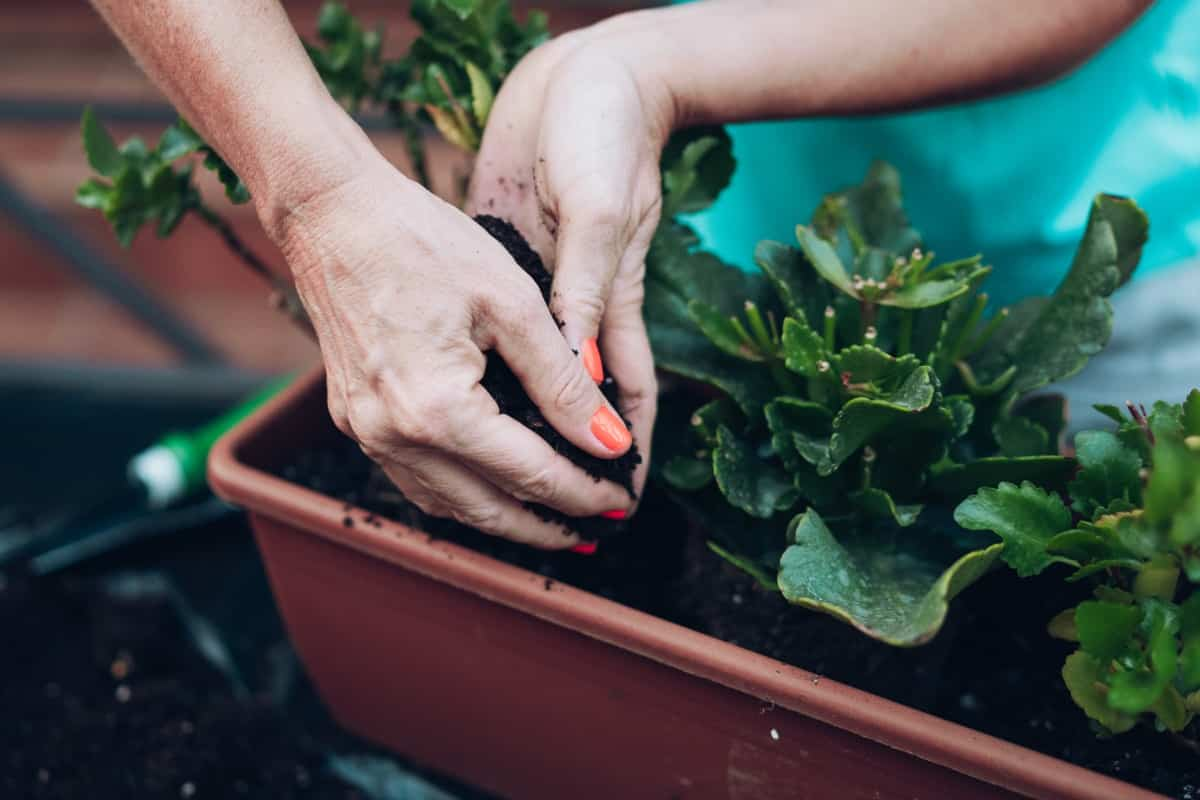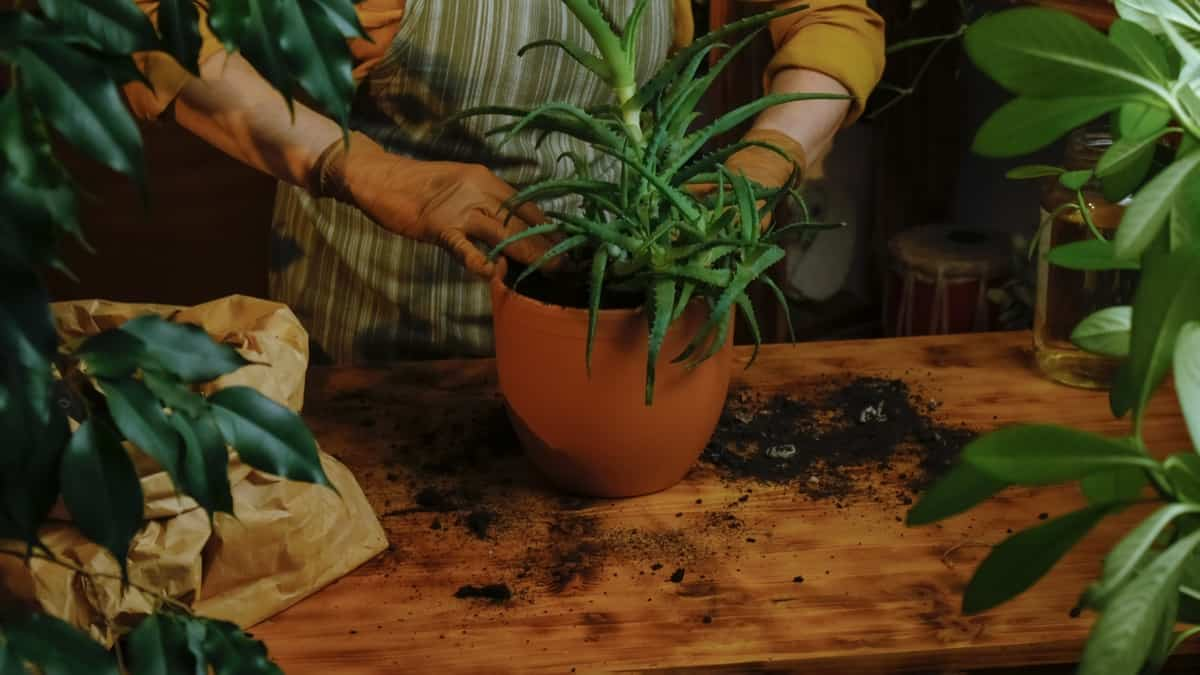Mulching is a common practice in gardening, and it offers numerous benefits for outdoor and indoor plants. Regarding indoor plants, mulching can help improve their overall health and appearance. However, it also has its disadvantages that need to be considered. This article will briefly explore the various types of mulch for indoor plants, the benefits of mulching indoor plants, and a guide on choosing the right mulch for your indoor plants.

What Is Mulching?
Covering the open surface of the ground with a layer of some external material is called mulching, and the material used for covering is called mulch. Mulching is usually practiced when cultivating commercially important crops, fruit trees, vegetables, flowers, nursery saplings, etc.
Best Types of Mulch for Indoor Plants
- Cedar Mulch for Indoor Plants: As a soil topper for indoor plants, cedar chips break down very slowly and provide a slight nutritional value to the soil over time. However, they aid moisture retention, look great in potted plants, and are a natural repellent to pesky bugs such as termites, ants, and slugs.
- Bark Mulch for Indoor Plants: Bark mulch is an excellent bio-degradable mulch. It retains moisture and looks decorative when used as mulch for potted plants.
- Wood Chips for Potted Plants are an excellent solution for areas where traditional mulch won’t work well. It will not shed, burn or float away in normal conditions.
- Gravel Mulch for Indoor Plants: Aquarium gravel or pea gravel is the best gravel for houseplants, but you can use pretty much any gravel as long as it is the correct size, clean and attractive.
Benefits of Mulching Indoor Plants
Moisture Retention: One of the primary benefits of mulching is it retains moisture in the soil. By creating a protective layer over the soil, mulch helps to reduce evaporation, thus minimizing the need for frequent watering.
Weed Suppression: Mulching is a natural weed suppressant for indoor plants. The layer of mulch prevents sunlight from reaching weed seeds, inhibiting their germination and growth.
Temperature Regulation: As a layer of insulation, mulch keeps the soil at a comfortable temperature. A thick layer of soil provides insulation against extreme temperature fluctuations, allowing the soil to stay cool during summer and warm during winter.
Moisture Retention With Mulch
Mulch is a layer of either organic or else inorganic material spread over the soil surface around plants. Does the mulch hold water? Yes, its primary function is to conserve moisture by reducing evaporation from the soil. By acting as a barrier, mulch helps to shield the soil from direct sunlight, preventing rapid water loss due to evaporation. Mulching can reduce water loss by how much percent? The plants with mulch used will need 25 percent less water than those without mulch.
In case you missed it: Homemade DIY Pine Needle Mulch Soil Fertilizer: Recipe for Natural and Organic Benefits of Plants

To apply it correctly, start by preparing the soil surface, removing any weeds or debris. Ensure that the soil is adequately moist before applying the mulch. Then, spread a layer of mulch around the plants, leaving a small gap around the plant stems to prevent moisture-related issues like rot. Finely shredded hard bark, pine mulch, and wood chips are the best for water retention.
Temperature Regulation With Mulch
Mulch is a protective layer covering the soil, providing insulation and reducing temperature fluctuations. Mulch can keep the soil cool in warmer climates by reflecting sunlight and reducing evaporation. This is especially helpful for plants that are sensitive to extreme heat. Mulch can prevent plant stress and promote healthy growth by lowering soil temperature.
On the other hand, in colder climates, mulch can act as an insulator, keeping the soil warmer by trapping heat generated by the soil. This is particularly useful in winter when freezing temperatures can damage plants. Mulch acts as a barrier against the cold air, keeping the soil temperature more stable and protecting the roots of plants from freezing.
Weed Suppression With Mulch
Best Weed Suppression With Mulch: Organic mulches, such as wood chips, straw, or bark, are commonly used. These materials break down over time, enriching the soil and improving its structure. As they decompose, organic mulches also release nutrients that benefit the plants.
Best Mulch Type to Prevent Weeds And Bugs: Gravel or stone mulch is durable and low-maintenance. It creates a barrier that minimizes weed growth and discourages bugs from burrowing into the soil. However, it may absorb heat and affect soil temperature in hot climates.
Improvement of Soil Health With Mulch
Organic mulches, such as hay or straw, gradually decompose, enriching the soil with organic matter. As the mulch breaks down, it releases essential nutrients and microorganisms into the soil, promoting soil fertility and supporting healthy plant growth. This nutrient cycling process improves the soil structure, enhances nutrient availability, and fosters beneficial soil microbial activity.
Potential Pest Control Benefits With Mulch
One of the key advantages of using mulch for pest control is its ability to create a physical barrier between pests and the soil. Many insects and pests, such as fungus gnats, mealybugs, and spider mites, rely on the soil as their breeding ground. Applying a layer of mulch can prevent these pests from accessing the soil and laying eggs, effectively reducing their population.
In case you missed it: How Mulching and Composting Can Solve Summer Garden Challenges

Mulch also acts as a deterrent for certain pests. Some types of mulch, such as cedar chips or pine needles, release natural oils or compounds that repel insects. These natural repellents can help keep pests at bay and protect indoor plants from infestation.
Esthetics and Decorative Purposes
One of the primary reasons for using mulch in indoor plants is to improve the overall aesthetic of the plant arrangement. Mulch comes in various colors, textures, and materials, allowing you to choose the one that best complements your interior decor. Whether you prefer a natural and earthy look with organic mulch or a more modern and sleek appearance with colored mulch, options suit every style and preference.
By creating a layer of mulch on top of the soil, you can trap moisture and prevent it from evaporating quickly. This is especially beneficial in indoor environments where humidity levels can be lower than optimal for plant growth.
Disadvantages of Using Mulch for Indoor Plants
Fungal Growth: Mulch provides an ideal environment for fungi to thrive, especially in the warm and humid conditions typically found indoors. Fungal infections can affect the health of indoor plants and may require extensive measures to eradicate.
Overwatering Risk: Overwatering is a common problem in indoor gardening, and using mulch can exacerbate this issue. Mulch can retain moisture for longer, leading to excessive watering and waterlogged soil. Over time, this can cause root rot and other moisture-related problems that can harm the health of indoor plants.
Choosing the Right Mulch for Indoor Plants
One crucial factor to consider is the moisture retention capability of the mulch. Indoor plants require consistent moisture levels, and mulch can help retain the soil’s moisture. Organic mulches, like wood chips and straw, are the best choices. Another factor to consider is the insulation properties of the mulch.
In case you missed it: Ultimate Guide to Using Straw As Garden Mulch for an Optimistic Organic Future

Indoor plants can be sensitive to temperature fluctuations, and mulch can act as an insulating barrier, protecting the roots from extreme temperatures. Lastly, consider the aesthetic aspect of the mulch. Indoor plants add beauty and freshness to your living space, and choosing the right mulch can enhance their visual appeal. Organic mulches, like bark or wood chips, provide a natural and earthy look.
Conclusion
mulching indoor plants offer various benefits. However, be aware of the potential disadvantages, such as overwatering risks, fungal growth, and possibly introducing pests or diseases. You can create a healthy and aesthetically pleasing indoor garden by choosing the right mulch and practicing proper maintenance.
- Feed Your Flock for Less: Top 10 Tips to Save on Chicken Feed
- Ultimate Guide to Ossabaw Island Hog: Breeding, Raising, Diet, and Care
- Hatching Answers: The Top 10 Reasons Your Chickens Aren’t Laying Eggs
- Eggs and Economics: Breaking Down the Cost of Raising Backyard Chickens
- Defend Your Greens: Proven Methods to Keep Iguanas Out of Your Garden
- Ultimate Guide to Cinnamon Queen Chicken: A Comprehensive Guide for Beginners
- Ultimate Guide to California Tan Chicken: Breeding, Raising, Diet, Egg-Production and Care
- Ultimate Guide to Marsh Daisy Chicken: Breeding, Raising, Diet, and Care
- 10 Types of Chicken Farming Businesses You Can Start for Profits